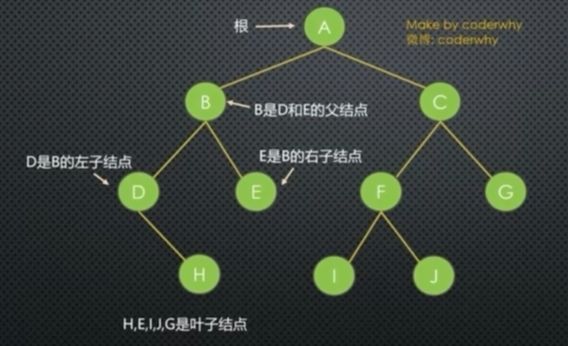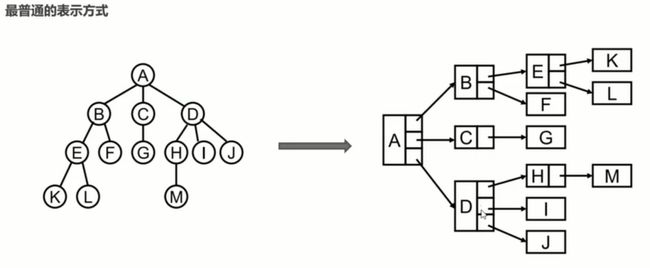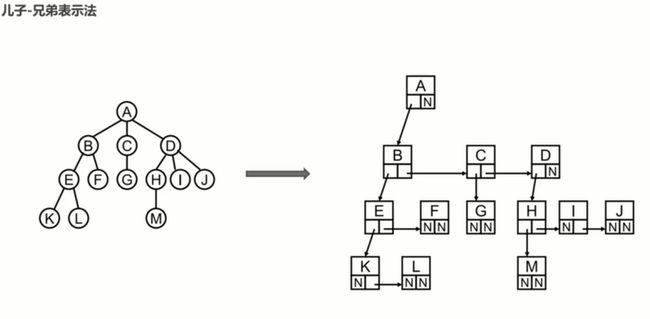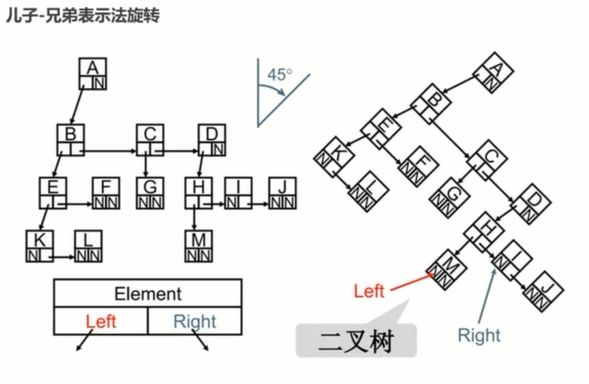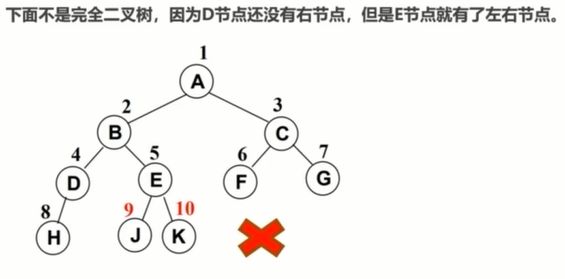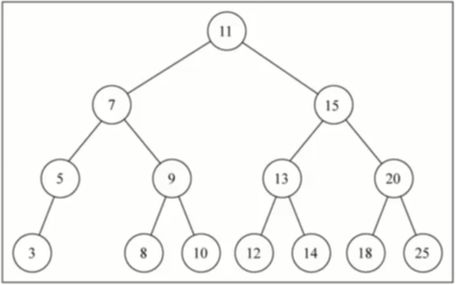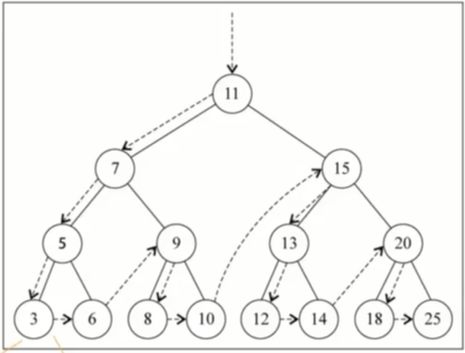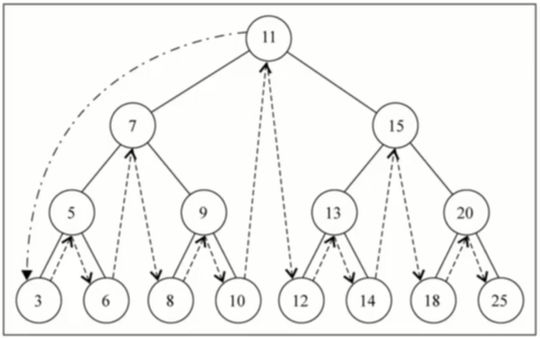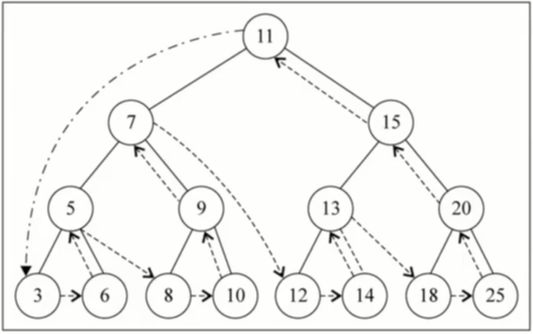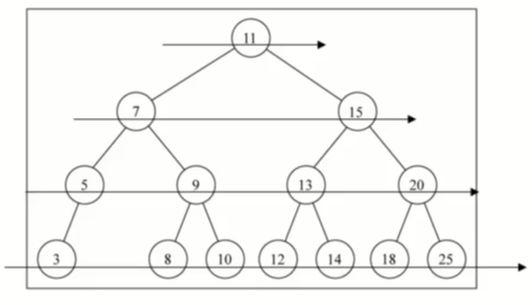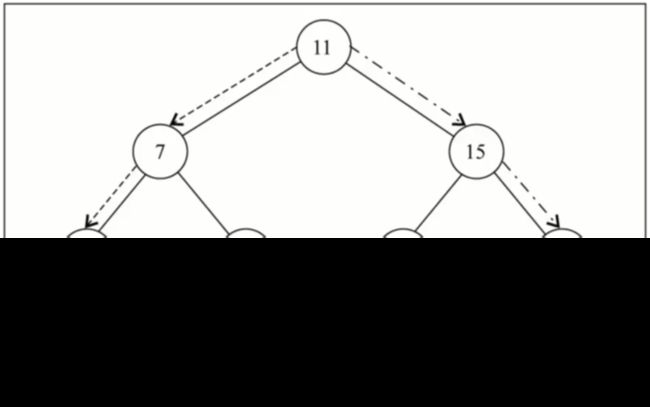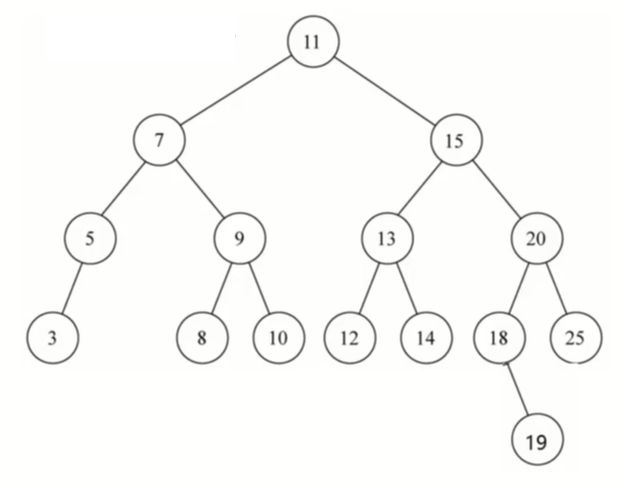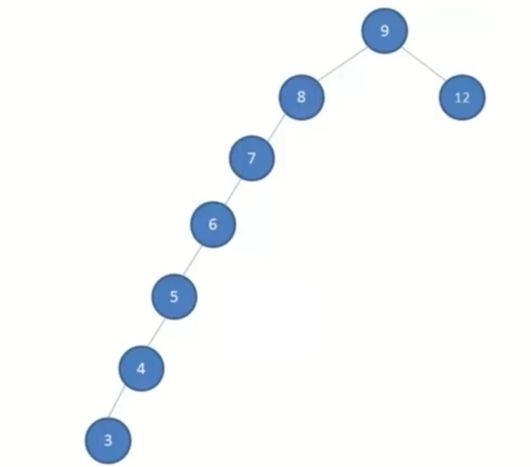TypeScript_树结构-BST树
树结构
树的特点
- 树通常有一个根。连接着根的是树干
- 树干到上面之后会进行分叉成树枝,树枝还会分又成更小的树枝
- 在树枝的最后是叶子
树的抽象
- 树可以模拟生活中的很多场景,比如:公司组织架构、家谱、DOM Tree、电脑文件夹架构
优秀的哈希函数(补充)
- 快速计算:霍纳法则
- 均匀分布:质数(长度、幂的底)
数据结构对比
数组
- 优点
- 数组的主要优点是根据 下标值访问 效率会很高
- 但是如果我们希望根据元素来查找对应的位置呢?
- 比较好的方式先对数组进行排序,再进行二分查找
- 缺点
- 需要 先对数组进行排序,生成有序数组,才能提高查找效率
- 另外数组和插入和删除数据时,需要有大量的位移操作(插入到首位或者中间位置的时候)效率很低
链表
- 优点
- 链表的插入和删除操作效率都很高
- 缺点
- 查找效率很低,需要从头开始依次访问链表中的每个数据项,直到找到
- 而且即使插入和删除操作操作效率很高,但是如果要插入和删除中间位置的数据,还是需要从头先找到对应的数据
哈希表
- 优点
- 哈希表的插入、查询、删除效率都是非常高的
- 缺点
- 空间利用率不高,底层使用的数组,并且某些单元是没有被利用的
- 哈希表中的元素是无序的,不能安装固定的顺序来遍历哈希表中的元素
- 不能快速的找出哈希表中的 最大值或最小值 这些特殊的值
树
- 不能说树结构比其他结构都要好,因为 每种数据结构都有自己的特定的应用场景
- 但是树确实综合了上面的数据结构的优点,并且弥补了上面数据结构的缺点
而且模拟某些场景,我们使用树结构会更加方便
- 因为数结构的非线性,可以表示一对多的关系
- 比如:文件的目录结构
树的术语
不过大部分术语都与真实世界的树相关,或者和家庭关系相关(如父节点和子节点)
树(Tree):n(n>=0)个节点构成的有限集合
- 当 n=0 时,称为空树
对于任一颗非空树(n>0),它具备以下性质:
- 树中有一个称为 “根(Root)” 的特殊节点,用 r 表示
- 其余节点可分为 m(m>0)个互不相交的有限集 T1、T2…Tm,其中每个集合本身又是一棵树,称为原来数的 “子树(SubTree)”
- 节点的度(Degree):节点的子树个数
- 树的度(Degree):树的所有节点的最大度数
- 叶节点(Leaf):度为 0 的节点(也称为叶子节点)
- 父节点(Parent):有子树节点时其子树的根节点的父节点
- 子节点(Child):若 A 节点是 B 节点的父节点,则称 B 节点是 A 节点的子节点,子节点也称孩子节点
- 兄弟节点(Sibling):具有同一父节点的各节点彼此是兄弟节点
- 路径和路径长度:从节点 n1 到 nk 的路径为一个节点序列 n1、n2…nk
- ni 是 n(i+1) 的父节点
- 路径所包含边的个数为路径的长度
- 节点的层次(Level):规定节点在 1 层,其它任一节点的层数是其父节点的层数+1
- 树的深度(Depth):树中所有节点中的最大层次是这棵树的深度
表示方法
所有的数本质上都可以使用二叉树模拟出来
二叉树
二叉树分类
如果树中每个节点 最多只能有两个子节点,这样的数就称为 “二叉树”
- 二叉树可以为空,也就是没有节点
- 若不为空,则它是由根节点和称为其 左子树TL 和 右子树TR 的两个不相交的二叉树组成
二叉树有几个比较重要的特性,笔试题中比较常见:
- 一颗二叉树第 i 层的最大节点树为:
2^(i-1), i>=1 - 深度为 k 的二叉树有最大节点总数为:
2^k-1, k>=1 - 对任何非空二叉树 T,若 n0 表示叶子点的个数,n2 是度为 2 的非叶节点个数,那么两者满足关系 n0=n2+1
完美二叉树(Perfect Binary Tree),也称满二叉树(Full Binary Tree)
- 在二叉树中,除了下一层的叶节点外,每层节点都有 2 个子节点,就构成了满二叉树
完全二叉树(Complete Binary Tree)
- 除二叉树最后一层外,其它各层的节点个数都达到最大个数
- 最后一层从左到右的叶节点连续存在,只缺右侧若干节点
- 完美二叉树是特殊的完全二叉树
二叉树存储
二叉树的存储常见的方式是数组和链表
二叉树最常见的方式还是使用链表存储
- 每个节点封装成一个 Node,Node 中包含存储的数据,左节点的引用,右节点的引用
二叉搜索树
二叉搜索树(BST,Binary Search Tree),也称二叉排序树或二叉查找树
二叉搜索树是一颗二叉树,可以为空,如果不为空,满足以下性质:
- 非空左子树的所有键值小于根节点的键值
- 非空右子树的所有键值大于其根节点的键值
- 左、右子树本身也都是二叉搜索树
这种方式就是二分查找的思想:
- 查找所需的最大次数等于二叉搜索树的深度
- 插入节点,也利用类似的方法,一层层比较大小,找到新节点合适的位置
封装二叉搜索树
常见操作
插入操作:
- insert(value):向树中插入一个新的数据
查找操作:
- search(value):在树中查找一个数据,如果节点存在,则返回 true;如果不存在,则返回 false
- min:返回树中最小的值/数据
- max:返回树中最大的值/数据
遍历操作:
- inOrderTraverse:通过中序遍历方式遍历所有节点
- preOrderTraverse:通过先序遍历方式遍历所有节点
- postOrderTraverse:通过后序遍历方式遍历所有节点
- levelOrderTraverse:通过层序遍历方式遍历所有节点
删除操作:
- remove(value):从树中移除某个数据
插入数据
- 插入其他节点时,我们需要判断该值到底是插入到左边还是插入到右边
- 判断的依据来自于新节点的 value 和原来节点的 value 值的比较
- 如果新节点的 newValue 小于原节点的 oldValue,那么就向左边插入
- 如果新节点的 newValue 大于原节点的 oldValue,那么就向右插入
- 代码1位置,就是准备向左子树插入数据,但是它本身有分成两种情况
- 情况一:左子树上原来没有内容,那么直接插入即可
- 情况二:左子树上已经有了内容,那么久一次向下继续查找新的走向,所以使用递归调用即可
- 代码2位置,和代码1位置几乎逻辑是相同的,只是去向右查找
- 情况一:左右树上原来没有内容,那么直接插入即可
- 情况二:右子树上已经有了内容,那么就一次向下继续查找新的走向,所以使用递归调用即可
class BSTree<T> {
private insertNode(node: TreeNode<T>, newNode: TreeNode<T>) {
// 代码1
if (newNode.value < node.value) {
// 去左边继续查找空白位置
if (node.left === null) {
node.left = newNode
} else {
this.insertNode(node.left, newNode)
}
// 代码2
} else {
// 去右边继续查找空白位置
if (node.right === null) {
node.right = newNode
} else {
this.insertNode(node.right, newNode)
}
}
}
}
遍历数据
- 遍历一棵树是指访问树的每个节点(也可以对每个节点进行某些操作,我们这里就是简单的打印)
- 但是树和线性结构不太一样,线性结构我们通常按照从前到后的顺序遍历,但是树呢?
- 应该从树的顶端还是底端开始呢?从左开始还是从右开始呢?
二叉树遍历常见的四种方式:
- 先序遍历
- 中序遍历
- 后序遍历
- 层序遍历
先序/中序/后序:取决于访问根节点(root)的时机
- 在所有的树结构中(包括子树)都是如此
先序遍历
- 优先访问根节点
- 之后访问左子树
- 最后访问右子树
- 递归版本
class TreeNode<T> extends Node<T> {
preOrderTraverse() {
this.preOrderTraverseNode(this.root)
}
private preOrderTraverseNode(node: TreeNode<T> | null) {
if (node) {
console.log(node.value)
this.preOrderTraverseNode(node.left)
this.preOrderTraverseNode(node.right)
}
}
}
- 非递归版本
class TreeNode<T> extends Node<T> {
preOrderTraversalNoRecursion() {
let stack: TreeNode<T>[] = []
let current: TreeNode<T> | null = this.root
while (current !== null || stack.length !== 0) {
while (current !== null) {
console.log(current.value)
stack.push(current)
current = current.left
}
current = stack.pop()!
current = current.right
}
}
}
中序遍历
- 优先访问左子树
- 之后访问根节点
- 最后访问右子树
- 递归版本
class TreeNode<T> extends Node<T> {
inOrderTraverse() {
this.inOrderTraverseNode(this.root)
}
private inOrderTraverseNode(node: TreeNode<T> | null) {
if (node) {
this.inOrderTraverseNode(node.left)
console.log(node.value)
this.inOrderTraverseNode(node.right)
}
}
}
- 非递归版本
class TreeNode<T> extends Node<T> {
inOrderTraversalNoRecursion() {
let stack: TreeNode<T>[] = []
let current: TreeNode<T> | null = this.root
while (current !== null || stack.length !== 0) {
while (current !== null) {
stack.push(current)
current = current.left
}
current = stack.pop()!
console.log(current.value)
current = current.right
}
}
}
后序遍历
- 优先访问左子树
- 之后访问右子树
- 最后访问根节点
- 递归版本
class TreeNode<T> extends Node<T> {
postOrderTraverse() {
this.postOrderTraverseNode(this.root)
}
private postOrderTraverseNode(node: TreeNode<T> | null) {
if (node) {
this.postOrderTraverseNode(node.left)
this.postOrderTraverseNode(node.right)
console.log(node.value)
}
}
}
- 非递归版本
class TreeNode<T> extends Node<T> {
preOrderTraversalNoRecursion() {
let stack: TreeNode<T>[] = []
let current: TreeNode<T> | null = this.root
while (current !== null || stack.length !== 0) {
while (current !== null) {
console.log(current.value)
current = current.left
}
current = stack.pop()!
stack.push(current)
current = current.right
}
}
}
层序遍历
层序遍历很好理解,就是从上向下逐层遍历
层序遍历通常我们会借助队列来完成
- 也是队列的一个经典应用场景
class TreeNode<T> extends Node<T> {
levelOrderTraverse() {
// 1.如果没有根节点,那么不需要遍历
if (!this.root) return
// 2.创建队列结构
const queue: TreeNode<T>[] = []
queue.push(this.root)
// 3.遍历队列中所有的节点(依次出队)
while (queue.length) {
// 3.1.访问节点的过程
const current = queue.shift()!
console.log(current.value)
// 3.2.将左子节点放入队列
if (current.left) {
queue.push(current.left)
}
// 3.3.将右子节点放入到队列
if (current.right) {
queue.push(current.right)
}
}
}
}
最值
在二叉搜索树中搜索最值是一件非常简单的事情,其实用眼睛就可以看出来了
class TreeNode<T> extends Node<T> {
/** 获取最值操作:最大值 */
getMaxValue(): T | null {
let current = this.root
while (current && current.right) {
current = current.right
}
return current?.value ?? null
}
/** 获取最值操作:最小值 */
getMinValue(): T | null {
let current = this.root
while (current && current.left) {
current = current.left
}
return current?.value ?? null
}
}
搜索特定的值
二叉搜索树不仅仅获取最值效率非常高,搜索特定的值效率也非常高
- 注意:这里的实现返回 boolean 类型即可
class TreeNode<T> extends Node<T> {
searchNoRecursion(value: T): boolean {
let current = this.root
while (current) {
// 找到了节点
if (current.value === value) return true
if (current.value < value) {
current = current.right
} else {
current = current.left
}
}
return false
}
search(value: T): boolean {
return this, this.searchNode(this.root, value)
}
searchNode(node: TreeNode<T> | null, value: T): boolean {
// 1.如果节点为null,那么就直接退出递归
if (node === null) return false
// 2.判断node节点的value和传入的value的大小
if (node.value > value) {
return this.searchNode(node.left, value)
} else if (node.value < value) {
return this.searchNode(node.right, value)
} else {
return true
}
}
}
删除操作
二叉搜索树的删除有些复杂,我们一点点完成
删除节点要从查找到删除的节点开始,找到节点后,需要考虑三种情况:
- 该节点是叶节点(没有子节点,比较简单)
- 该节点有一个子节点(相对简单)
- 该节点有两个子节点(情况复杂)
我们先从查找要删除的节点入手
- 先找到要删除的节点
- 找到要删除节点
- 删除叶子节点
- 删除只有一个子节点
- 删除有两个子节点的节点
class TreeNode<T> extends Node<T> {
left: TreeNode<T> | null = null
right: TreeNode<T> | null = null
parent: TreeNode<T> | null = null
get isLeft(): boolean {
return !!(this.parent && this.parent.left === this)
}
get isRight(): boolean {
return !!(this.parent && this.parent.right === this)
}
}
class TreeNode<T> extends Node<T> {
private searchNode(value: T): TreeNode<T> | null {
let current = this.root
let parent: TreeNode<T> | null = null
while (current) {
if (current.value === value) return current
parent = current
if (current.value < value) {
current = current.right
} else {
current = current.left
}
if (current) current.parent = parent
}
return null
}
}
情况一:没有子节点
- 这种情况相对比较简单,我们需要检测 current 的 left 以及 right 是否都为 null
- 都为 null 之后还要检测一个东西,就是是否 current 就是根,都为 null,并且为根,那么相当于清空了根,因为只有它
- 否则就把父节点的 left 或者 right 字段设置为 null 即可
如果只有一个单独的根,直接删除即可
- 如果是叶节点,那么处理方式如下
class TreeNode<T> extends Node<T> {
remove(value: T): boolean {
// 1.搜索当前是否有这个value
const current = this.searchNode(value)
if (!current) return false
// 2.获取到三个东西:当前节点/父节点是否属于父节点的左子节点还是右子节点
// 2.1.如果删除的是叶子节点
if (current.left === null && current.right === null) {
if (current === this.root) {
// 根节点
this.root = null
} else if (current.isLeft) {
// 父节点的左子节点
current.parent!.left = null
} else {
current.parent!.right = null
}
}
return true
}
}
情况二:一个子节点
- 这种情况也不是很难
- 要删除的 current 节点,只有 2 个连接(如果有两个子节点,就是三个连接了),一个连接父节点,一个连接唯一的子节点
- 需要从这三者之间:爷爷-自己-儿子,将自己(current)剪断,让爷爷直接连接儿子即可
- 这个过程要求改变父节点的 left 或者 right,指向要删除节点的子节点
- 当然,这个过程中还要考虑是否 current 就是根
class TreeNode<T> extends Node<T> {
remove(value: T): boolean {
if (current.right === null) {
// 2.2.只有一个子节点,只有左子节点
if (current === this.root) {
this.root = current.left
} else if (current.isLeft) {
current.parent!.left = current.left
} else {
current.parent!.right = current.left
}
} else if (current.left === null) {
// 2.3.只有一个子节点,只有右子节点
if (current === this.root) {
this.root = current.right
} else if (current.isLeft) {
current.parent!.left = current.right
} else {
current.parent!.right = current.right
}
}
return true
}
}
情况三:两个节点
- 情况一:删除 9 节点
- 处理方式相对简单,将 8 位置替换到 9,或者将 10 位置替换到 9
- 注意:这里是替换,也就是 8 位置替换到 9 时,7 指向 8,而 8 还需要指向 10
- 找 8 或 10
- 情况二:删除 7 节点
- 一种方式是将 5 拿到 7 的位置,3 依然指向 5,但是 5 有一个 right,需要指向 9,依然是二叉搜索树
- 另一种方式是在右侧找一个,找 8
- 也就是将 8 替换到 7 的位置,8 的 left 指向 5,right 指向 9,依然是二叉搜索树
- 找 5 或 8
- 情况三:删除 15 节点,并且我希望也在右边找
- 18 替换 15 的位置,20 的 left 指向 19,也是一个二叉搜索树
- 找 14 或 18
class TreeNode<T> extends Node<T> {
private getSuccessor(delNode: TreeNode<T>) {
// 获取右子树
let current = delNode.right
let successor: TreeNode<T> | null = null
while (current) {
successor = current
current = current.left
if (current) {
current.parent = successor
}
}
// 拿到后继节点
if (successor !== delNode.right) {
successor!.parent!.left = successor!.right
successor!.right = delNode.right
}
// 将删除节点的 left,赋值给后继节点的 left
successor!.left = delNode.left
return successor
}
remove(value: T): boolean {
else {
// 2.4.两个子节点
const successor = this.getSuccessor(current)
if (current === this.root) {
this.root = successor
} else if (current.isLeft) {
current.parent!.left = successor
} else {
current.parent!.right = successor
}
}
return true
}
}
寻找规律
如果我们要 删除的节点有两个子节点,甚至子节点还有子节点,这种情况下我们需要 从下面的子节点中找到一个子节点,来替换当前的节点
但是找到这个节点有什么特征呢?应该是 current 节点下面所有节点中 最接近 current 节点 的
- 要么比 current 节点小一点点,要么比 current 节点大一点点
- 总结你最接近 current,你就可以用来替换 current 的位置
这个节点怎么找呢?
- 比 current 小一点点的节点,一定是 current 左子树的最大值
- 比 current 大一点点的节点,一定是 current 右子树的最小值
前驱和后继
- 在二叉搜索树中,这两个特别的节点,有两个特别的名字
- 比 current 小一点点的节点,称为 current 节点的 前驱
- 比 current 大一点点的节点,称为 current 节点的 后继
也就是为了能够删除有两个子节点的 current,要么找到它的前驱,要么找到它的后继
class TreeNode<T> extends Node<T> {
remove(value: T): boolean {
// 1.搜索当前是否有这个value
const current = this.searchNode(value)
if (!current) return false
// 2.获取到三个东西:当前节点/父节点是否属于父节点的左子节点还是右子节点
let replaceNode: TreeNode<T> | null = null
if (current.left === null && current.right === null) {
// 2.1.如果删除的是叶子节点
replaceNode = null
} else if (current.right === null) {
// 2.2.只有一个子节点,只有左子节点
replaceNode = current.left
} else if (current.left === null) {
// 2.3.只有一个子节点,只有右子节点
replaceNode = current.right
} else {
// 2.4.两个子节点
const successor = this.getSuccessor(current)
replaceNode = successor
}
if (current === this.root) {
this.root = replaceNode
} else if (current.isLeft) {
current.parent!.left = replaceNode
} else {
current.parent!.right = replaceNode
}
return true
}
}
删除操作非常复杂,一些程序员都尝试着避开删除操作
- 他们的做法是在 Node 类中添加一个 boolean 字段,比如名称为 isDeleted
- 要删除一个节点时,就将此字段设置为 true
- 其他操作,比如 find() 在查找之前先判断这个节点是不是标记为删除
- 这样相对比较简单,每次删除节点不会改变原有的树结构
- 但是在二叉树的存储中,还保留这那些本已经被删除掉的节点
完整代码
import { btPrint } from 'hy-algokit'
class INode<T> {
value: T
constructor(value: T) {
this.value = value
}
}
class TreeNode<T> extends Node<T> {
left: TreeNode<T> | null = null
right: TreeNode<T> | null = null
parent: TreeNode<T> | null = null
get isLeft(): boolean {
return !!(this.parent && this.parent.left === this)
}
get isRight(): boolean {
return !!(this.parent && this.parent.right === this)
}
}
class BSTree<T> {
private root: TreeNode<T> | null = null
print() {
btPrint(this.root)
}
private searchNode(value: T): TreeNode<T> | null {
let current = this.root
let parent: TreeNode<T> | null = null
while (current) {
if (current.value === value) return current
parent = current
if (current.value < value) {
current = current.right
} else {
current = current.left
}
if (current) current.parent = parent
}
return null
}
/** 插入数据的操作 */
insert(value: T) {
// 1.根据传入value创建Node(TreeNode)节点
const newNode = new TreeNode(value)
// 2.判断当前是否已经有了根节点
if (!this.root) {
// 当前树为空
this.root = newNode
} else {
// 树中已经有其他值
this.insertNode(this.root, newNode)
}
}
private insertNode(node: TreeNode<T>, newNode: TreeNode<T>) {
if (newNode.value < node.value) {
// 去左边继续查找空白位置
if (node.left === null) {
node.left = newNode
} else {
this.insertNode(node.left, newNode)
}
} else {
// 去右边继续查找空白位置
if (node.right === null) {
node.right = newNode
} else {
this.insertNode(node.right, newNode)
}
}
}
// 遍历的操作
/** 先序遍历 */
preOrderTraverse() {
this.preOrderTraverseNode(this.root)
}
private preOrderTraverseNode(node: TreeNode<T> | null) {
if (node) {
console.log(node.value)
this.preOrderTraverseNode(node.left)
this.preOrderTraverseNode(node.right)
}
}
/** 中序遍历 */
inOrderTraverse() {
this.inOrderTraverseNode(this.root)
}
private inOrderTraverseNode(node: TreeNode<T> | null) {
if (node) {
this.inOrderTraverseNode(node.left)
console.log(node.value)
this.inOrderTraverseNode(node.right)
}
}
/** 后序遍历 */
postOrderTraverse() {
this.postOrderTraverseNode(this.root)
}
private postOrderTraverseNode(node: TreeNode<T> | null) {
if (node) {
this.postOrderTraverseNode(node.left)
this.postOrderTraverseNode(node.right)
console.log(node.value)
}
}
/** 层序遍历 */
levelOrderTraverse() {
// 1.如果没有根节点,那么不需要遍历
if (!this.root) return
// 2.创建队列结构
const queue: TreeNode<T>[] = []
queue.push(this.root)
// 3.遍历队列中所有的节点(依次出队)
while (queue.length) {
// 3.1访问节点的过程
const current = queue.shift()!
console.log(current.value)
// 3.2将左子节点放入队列
if (current.left) {
queue.push(current.left)
}
// 3.3将右子节点放入到队列
if (current.right) {
queue.push(current.right)
}
}
}
/** 获取最值操作:最大值 */
getMaxValue(): T | null {
let current = this.root
while (current && current.right) {
current = current.right
}
return current?.value ?? null
}
/** 获取最值操作:最小值 */
getMinValue(): T | null {
let current = this.root
while (current && current.left) {
current = current.left
}
return current?.value ?? null
}
/** 搜索特定的值 */
search(value: T): boolean {
return !!this.searchNode(value)
}
searchNodeValue(node: TreeNode<T> | null, value: T): boolean {
// 1.如果节点为null,那么就直接退出递归
if (node === null) return false
// 2.判断node节点的value和传入的value的大小
if (node.value > value) {
return this.searchNodeValue(node.left, value)
} else if (node.value < value) {
return this.searchNodeValue(node.right, value)
} else {
return true
}
}
/** 删除操作 */
private getSuccessor(delNode: TreeNode<T>) {
// 获取右子树
let current = delNode.right
let successor: TreeNode<T> | null = null
while (current) {
successor = current
current = current.left
if (current) {
current.parent = successor
}
}
// 拿到后继节点
if (successor !== delNode.right) {
successor!.parent!.left = successor!.right
successor!.right = delNode.right
}
// 将删除节点的 left,赋值给后继节点的 left
successor!.left = delNode.left
return successor
}
remove(value: T): boolean {
// 1.搜索当前是否有这个value
const current = this.searchNode(value)
if (!current) return false
// 2.获取到三个东西:当前节点/父节点是否属于父节点的左子节点还是右子节点
let replaceNode: TreeNode<T> | null = null
if (current.left === null && current.right === null) {
// 2.1.如果删除的是叶子节点
replaceNode = null
} else if (current.right === null) {
// 2.2.只有一个子节点,只有左子节点
replaceNode = current.left
} else if (current.left === null) {
// 2.3.只有一个子节点,只有右子节点
replaceNode = current.right
} else {
// 2.4.两个子节点
const successor = this.getSuccessor(current)
replaceNode = successor
}
if (current === this.root) {
this.root = replaceNode
} else if (current.isLeft) {
current.parent!.left = replaceNode
} else {
current.parent!.right = replaceNode
}
return true
}
}
平衡树
二叉搜索树缺陷
二叉搜索树作为数据存储的结构有重要的优势
- 可以快速地找到给定关键字的数据项,并且可以快速地插入和删除数据项
但是,二叉搜索树有一个很麻烦的问题:
- 如果插入的数据是有序的数据,比如下面的情况
- 有一颗初始化为 9、8、12 的二叉树
- 插入下面的数据:7、6、5、4、3
非平衡树
- 比较好的二叉搜索树数据应该是 左右分布均匀 的
- 但是插入 连续数据 后,分布的不均匀,称这种树为非平衡树
- 对于一颗平衡二叉树来说,插入/查找等操作的效率是 O(logN)
- 对于一颗非平衡二叉树,相当于编写了一个链表,查找效率变成了 O(N)
平衡性
为了能以较快的时间 O(log N)来操作一棵树,我们需要保证树总是平衡的
- 至少大部分是平衡的,那么时间复杂度也是接近 O(logN) 的
- 也就是说树中 每个节点左边的子孙节点的个数,应该尽可能的等于 右边的子孙节点的个数
AVL 树
- AVL 树是最早的一种平衡树,它有些办法保证树的平衡(每个节点存储了一个额外的数据)
- 因为 AVL 树是平衡的,所以时间复杂度也是 O(logN)
- 但是,每次插入/删除操作相对于红黑树效率都不高,所以整体效率不如红黑树
红黑树
- 红黑树也通过一些特性来保持树的平衡
- 因为是平衡树,所以时间复杂度也是 O(logN)
- 另外插入/删除等操作,红黑树的性能要优于 AVL 树,所以现在平衡树的应用基本都是红黑树
